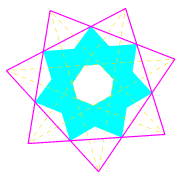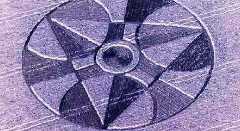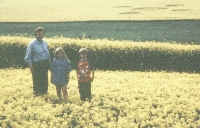
For the schoolchildren of tomorrow
| Front Page | Welcome | Two | Three | Four | Pentagram | Six | Spirals | The Plot Thickens | Astronomy | 2006 Formations |

Welcome to this 'Hypermaths' Website, concerning the geometry of crop circles. It is designed for school maths teachers who wish to bring a bit of inspiration into their lessons; to bring out the Harry Potter in their pupils, as it were.
Each unit contains a line-diagram of the essential form. Wherever possible there is a web-link to a photograph, of the formation; there may also be coloured-in figures, web-links to the work other geometers and feedback reports on use of the program. The modern maths teacher has a 'whiteboard' onto which she or he can download web-material.
The review of my book 'Crop circles, The Hidden Form' in the School Maths teachers journal observed www.atm.org.uk/reviews/books/cropcircles.html that it was 'a must for any school library.' It helps if you have a copy of that book www.wessexbooks.co.uk/cropcircles-hiddenform.htm and also, why not order the pack of six full-colour Hypermaths posters www.wessexbooks.co.uk/posters.htm while you're at it?
My understanding is that the forms that have arrived in English cornfields in the last decade or so are new, and are not an echo of what is found in texts about sacred geometry nor in old temple designs. I, as a science historian, have experienced a novelty here. They are a form of communication, and the message is nonverbal.
Websites that deal with crop circle geometry are to be found here: www.korncirkler.dk/cccorner/geometry.art.html. Most of them open our minds to the mystical. This site has, however, a different goal. It aims to help ordinary students to learn mathematics, in a unique approach that is artistic as well as intellectual. The Circlemakers have given us a repertoire of forms that are consciousness-expanding, a kind of holistic mathematics. Even students who can't do the trig can get value from colouring in the forms! Some of the geometry sites give a bewildering array of lines used in their reconstructions, but I here try not to lose sight of a primal simplicity with which the Circlemakers have done their work. For this, we will be drawing on the pioneer work of persons such as Bert Janssen www.bertjanssen.nl/cropcircles.html , John Martineau and Michael Glickman.
We look at what Aristotle called the 'formal' cause, which is the mathematical structure of the phenomenon. Of his four types of causes, the others will not concern us: the 'final' cause which asks for what purpose they were made, the 'efficient' cause which is the process by which they are made (planks? ultrasound?) and the 'material' cause as the substance (were there stalks with nodes bent in some special manner?). In the dizzying discussions that go on about the topic, a distinction between these different causes could just help to clarify things.
 It was fortunate that 'The Hidden Form' was published in 2002, because what I am here calling 'Hypermaths' had mainly appeared by then. The forms since that statement have tended to be somewhat complex for a school classroom. The majestic logic of the phenomenon has unfolded over about one decade, geo-metry in the most literal sense (from Greek geo-Earth, metros - measure) - to the accompaniment of media scorn, derision and silence. The phenomenon has been, as John Michell so rightly observed, 'the best show in England'. In struggling to discern the patterns that were developing, the gentle, sage council of the late Gerald Hawkins, the astronomer, helped to guide us: www.lovely.clara.net/hawkins.html He showed how the phenomenon expressed musical-harmonic ratios. My approach has been slightly different, and I describe the way it has manifested in whole-number patterns.
It was fortunate that 'The Hidden Form' was published in 2002, because what I am here calling 'Hypermaths' had mainly appeared by then. The forms since that statement have tended to be somewhat complex for a school classroom. The majestic logic of the phenomenon has unfolded over about one decade, geo-metry in the most literal sense (from Greek geo-Earth, metros - measure) - to the accompaniment of media scorn, derision and silence. The phenomenon has been, as John Michell so rightly observed, 'the best show in England'. In struggling to discern the patterns that were developing, the gentle, sage council of the late Gerald Hawkins, the astronomer, helped to guide us: www.lovely.clara.net/hawkins.html He showed how the phenomenon expressed musical-harmonic ratios. My approach has been slightly different, and I describe the way it has manifested in whole-number patterns.
For companion reading, I recommend all the Yearbooks by Karen Douglas and Steve Alexander, www.temporarytemples.co.uk/shop/yearbooks.html, Vital Signs by Andy Thomas www.vitalsignspublishing.co.uk/ and The Hypnotic Power of Crop Circles by Bert Janssen as basic texts. www.cropcircleconnector.com is the essential web picture-gallery, but one needs a subscription to access earlier years.
I have to put my hand on my heart and say that using these designs in the classroom will not cost a mathematics teacher their job: in fact, it cannot fail to enhance student interest in the subject.
For an artistic treatment of the images, see:
www.scottonstott.com/gallery/slideshow.php?set_albumName=artwork
For discussion of the formative process, see:
theconversation.org/booklet2.html
 Many thanks to Ben Cavanna for help with images, Andrew Gosling for preparing the web-format and Paul Vigay for hosting it.
Many thanks to Ben Cavanna for help with images, Andrew Gosling for preparing the web-format and Paul Vigay for hosting it.